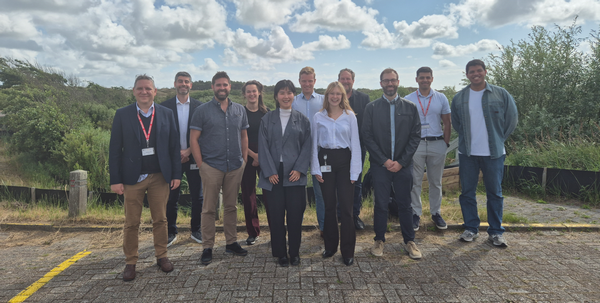

Accelerating the development of Anion Exchange Membrane electrolysers
20-10-2025
 In a new Shared Research Programme, TNO VoltaChem aims to broaden the technology scope for hydrogen production by boosting the development of Anion Exchange Membrane electrolysers. These electrolysers offer potential for greater geopolitical independence and reduced hydrogen production cost. The three-year programme has recently been launched with industrial partners Rely, John Cockerill Hydrogen, and Jolt. Interested companies across the value chain are welcome to join.
In a new Shared Research Programme, TNO VoltaChem aims to broaden the technology scope for hydrogen production by boosting the development of Anion Exchange Membrane electrolysers. These electrolysers offer potential for greater geopolitical independence and reduced hydrogen production cost. The three-year programme has recently been launched with industrial partners Rely, John Cockerill Hydrogen, and Jolt. Interested companies across the value chain are welcome to join.
According to TNO VoltaChem business developer Tara van Abkoude, AEM is the ‘new kid on the block’ in hydrogen generation, offering a ‘best of both worlds’ approach. “We have started this Shared Research Programme because AEM has the potential to significantly reduce the levelized cost of hydrogen while having the inherent advantage of avoiding critical raw materials. Developing a viable AEM electrolyser technology thus opens up a new, promising route for hydrogen production.”
A cost-efficient, PGM-free technology
Anion exchange electrolysers produce hydrogen using a semipermeable membrane that conducts hydroxide ions (OH−), while separating the hydrogen and oxygen products and providing electrical insulation between the electrodes. Their design resembles that of proton-exchange membrane (PEM) which, as the name indicates, conducts protons. While the latter feature an acidic operating environment, AEM electrolysis is alkaline in nature. This has the inherent advantage that it does not rely on high-cost noble Platinum Group Metals (such as platinum and iridium). Instead, it can utilise transition metal catalysts that are more abundantly available and less costly, such as nickel and iron.
While ‘traditional’ alkaline water electrolysis is a mature technology since more than a century, and PEM electrolysis has been commercialised over the last decade, AEM electrolysis is still in the early stage of research and development. To boost AEM development, TNO initiated a dedicated Shared Research Programme where partners along the value chain cooperate in a precompetitive, open innovation approach to perform more focused R&D and derisk technology development.
Kick-start of the Shared Research Programme AEM
The SRP in AEM electrolysers started this summer with a kick-off meeting together with the founding partners Jolt, Rely and John Cockerill Hydrogen. The Spanish company Jolt is a spin-off from the ICIQ research institute in Barcelona that is renowned for its catalysis research. It specialises in the production of activated electrodes (catalyst coated metallic substrates) for traditional alkaline electrolysis and novel AEM electrolysers. Jolt is leading the way in terms of large-scale production of AEM electrodes. As Wayne Thornhill, Chief Sales Officer for Jolt explains, this type of product is often much more complex than traditional electrodes and many manufacturers struggle to make them. “Jolt is working with our partners at TNO on several projects and we are proud to be a full partner of the shared research program, helping to improve the integration of our electrodes with other components.”
Rely will contribute to the research program with its expertise in large-scale industrial installations in terms of safety, energy management, industrialization and maintainability. Rely was established in 2023 in Belgium by Technip Energies and John Cockerill to address the urgent need to scale up green hydrogen and Power-to-X technologies to decarbonize hard-to-abate industries. Rely notably developed a 100MW+ green hydrogen productized plant (called Clear100+) which integrates pressurized alkaline electrolysers from John Cockerill Hydrogen, with which it cooperates in a Joint Innovation Platform. Jean Jouet, Chief Technology Officer of Rely: “As industrial players, we are proud to be able to participate in such a pioneering research project, demonstrating our commitment to limitless innovation and our willingness to explore every pathway towards industrial decarbonization. Exploring all technology avenues allows us to enhance the performance of green hydrogen production.”
TNO coordinates the programme and contributes both expertise and facilities. At the Faraday Lab, a representative cell/stack environment offers a testbed for new components, and test protocols provide insight in performance and lifetime. TNO researchers led by Marco Wonink (science lead) and Jeannet Liang (project manager) will conduct experiments and develop a detailed cost model, which will provide insights on how technological developments on component level translate to the performance and costs of a system under operation. Developing such a performance model is a crucial aspect of the programme, providing direction for the development of various component concepts.
Participation is still open
The aim of the SRP AEM is to build a shared foundation with partners to explore how technological innovations translate into performance, durability, and ultimately the cost of future AEM electrolyser systems. Participation is still open, and Marco Wonink invites interested parties to join the programme: “Our joint approach to R&D is not only about accelerating development and reducing time-to-market. It is also about doing so together, about learning and growing together, and steering the direction of our research as one. Every new partner adds momentum. The more voices from across the value chain can be heard, the faster we can bring next-generation AEM electrolysers to life.”
Do you want to know more about the shared research programme, contact TNO Voltachem business developer Tara van Abkoude, phone: +31 6 1780 96 45.
On the photo: Participants in the kick-off meeting earlier this summer. Left to right: Thibault De-Sorbier (Rely), Mert Colakoglu (TNO), Jordi Creus Casanovas (Jolt), Tara van Abkoude (TNO), Jeannet Liang (TNO), Marco Wonink (TNO), Ellis Donker (TNO), Arend de Groot (TNO), Alberto Bucci (Jolt), Amin Farkhondehfal (John Cockerill), Luis Enrique Botello (Jolt).
Share this page: